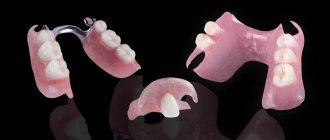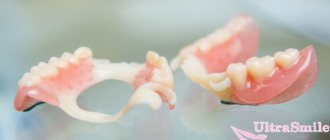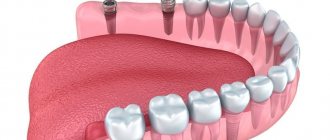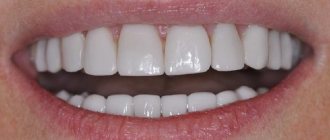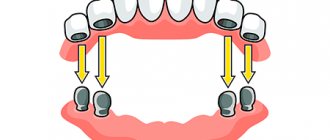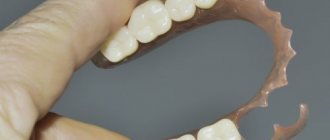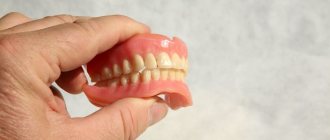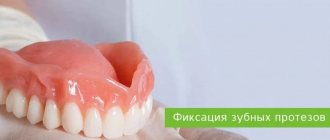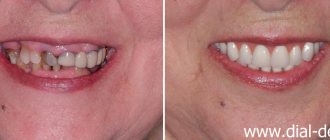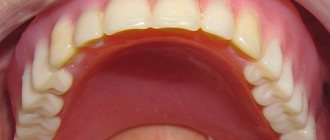- Design of a removable lamellar prosthesis
- Removable plate denture price
- When are plate dentures used?
- Advantages and disadvantages of plate prostheses
- Removable plate dentures in Moscow
Partially removable laminar dentures, outwardly indistinguishable from real teeth, will help restore the beauty of a smile and restore chewing functions after the loss of several teeth. The plate prosthesis is accessible, functional, and practical, but you need to get used to it so as not to feel discomfort.
Design features
A removable lamellar prosthesis consists of a base, retaining devices, and artificial organs. It effectively reduces the mobility of the base teeth, evenly distributes the load on the tissues of the prosthetic bed, and has maximum working efficiency. The emergence of innovative materials, improvement of milling techniques and the use of high-precision casting have significantly expanded the possibilities of manufacturing plate-based devices. Thanks to this method, modern acrylic structures are aesthetically pleasing, do not require a lot of getting used to, and do not cause discomfort. After examining the patient’s oral cavity and performing preventive/therapeutic procedures, an impression is taken to create a model of the product. Dental laboratory specialists make the prosthesis, polish and grind it. The orthopedic dentist installs the finished restoration in the oral cavity, correcting it if necessary.
When to use
A partially removable lamellar denture will help a patient who has unexpectedly lost several teeth. They are placed for a short period of time while permanent bridges are made for the patient. The main indications for wearing such a prosthesis are:
- There are no chewing teeth, but there are well-preserved supporting teeth. The cause may be a household or sports injury, tooth extraction due to complex dental diseases.
- There is no option to install implants for any reason.
- Severe allergic reaction to components of permanent structures.
Classification of plate prostheses
Removable prosthetics are carried out in several ways, depending on the topography and size of the defects in the rows. To select the optimal option, the stability of the bases, their localization in the arch, root length, crown height, defect length, characteristics of interocclusal relationships, and the degree of alveolar bone atrophy must be taken into account:
- complete plate prosthesis. It is used for absolute edentia and is made of acrylic plastic. A cast reinforcing base is used as a frame, giving the mechanism additional rigidity and strength. It is fixed by tightly fitting the base, creating a closing valve. On the upper jaw, the prosthesis is installed by creating negative pressure under the system, on the lower jaw - due to the complex relief and volume of the mass;
- partial. Indicated if the patient is missing a group or single organs in the frontal/lateral rows, with defects of large extent, or the absence of one unit as a temporary measure. In addition to the advantages, it has a number of disadvantages when worn for a long time: significant base, subsidence under the influence of vertical chewing loads, the formation of pathological pockets, compression of the gingival margin.
Removable products can be equipped with clasps (hooks), locks, and an arc that provide reliable fixation and ease of use.
Indications and contraindications for use
Partial removable dentures are used in cases where the jaw is missing only a few teeth, but there are own healthy teeth that will be used as supporting teeth. Suitable for restoring both chewing and front teeth. The use of removable partial dentures is recommended in the following cases:
- missing several teeth;
- end defects of the jaw;
- atrophied bone tissue;
- the need for temporary prosthetics;
- contraindications to the installation of implants.
There are practically no contraindications to this type of prosthetics, and they are all temporary. These include viral diseases, carious lesions of teeth and periodontal tissue diseases.
Manufacturing and installation of plate prostheses
A plate prosthesis is a design made from an individual impression, consisting of several parts, each of which repeats the anatomical features of the patient’s oral cavity.
Prosthetic elements:
Plastic base. Connecting part of the structure. For its production, pink plastic is used, which completely repeats the shape, color, relief of the gums and mucous membrane. Necessary for proper distribution of chewing load.
Artificial crowns. Mounted on a plastic base. They are made in shape and color identical to natural teeth.
Fixing elements. Depends on the type of structure. Presented in the form of an arc, clasps or locks. Implant-supported installation is also available.
Modeling of prosthetic elements in a dental laboratory goes through several stages and depends on the clinical picture, type of system, and installation method. Installation of the structure will require 3 to 5 visits to the dentist's office. During this time, the doctor will be able to carry out treatment, make an impression and adjust the finished structure to the teeth for comfortable wearing.
Stage 1. Consultation and examination. Before deciding on prosthetics, the dentist conducts an examination of the oral cavity. Additionally, studies are prescribed, including x-rays using modern equipment. Thanks to the examination, the doctor will receive a complete clinical picture and will be able to identify contraindications to certain drugs, materials or other types of medical procedures.
Stage 2. Taking impressions and manufacturing. The doctor takes impressions of the teeth using a special impression mass. This procedure may involve both jaws or one or part of it. The shade of the future system and the color of the artificial crowns are selected. The resulting impressions are sent to the dental laboratory, where the dental technician, using a digital protocol, models the shape of the prosthesis using a wax template - the base and crowns. The latest CAD/CAM technology is used to produce complete removable structures.
Stage 3. Trying and adjustment. The doctor tries on a wax template with bite ridges on the patient's teeth. Adjustments are made and the desired occlusion height is set, i.e. The patient's bite is checked and the appropriate height of the crowns is selected. If the fitting was successful, the doctor sends the results to the dental technician. Manufacturing the finished prosthesis in the laboratory takes about 2-3 weeks.
Stage 4. Installation of the finished product. The dentist installs the finished plate prosthesis and fixes it. The method of fixation depends on the type of structure and the condition of the bone tissue. After this, the doctor cleans and grinds the crowns. Sometimes complete removable structures are held in place due to the suction effect. If there are suction cups, specialized gels for dentures, which can be purchased at a pharmacy, are used for durable installation. They are usually used for the lower jaw.
Advantages and disadvantages
Each type of plate prosthesis has a number of advantages and disadvantages.
Fully removable dentures
The main advantages of such structures are:
- ease of manufacture;
- possibility of use regardless of age;
- minimum contraindications;
- aesthetics;
- lack of fasteners;
- low price.
An important advantage is the preservation of chewing function with complete edentia.
The disadvantages include:
- short service life (3-5 years);
- discomfort during the process of adaptation and use;
- difficulty chewing food of a certain consistency (hard and sticky).
In addition, the lower part of the prosthesis is poorly fixed; special glue must be applied to the lower jaw.
Partially removable structures
The advantages of partially removable systems are:
- lightness and elasticity when manufactured from soft plastic materials;
- aesthetic appearance;
- affordable price.
Patients get used to partially removable dentures faster, and chewing function is restored in a short time.
Disadvantages include:
- uneven distribution of load on bone tissue;
- discomfort from the plate on the palate, which provokes a deterioration in diction and chewing functions.
The fragility of the structure can lead to plate fracture.
Plate systems on implants
The advantages of plate prostheses installed on implants include:
- no need to grind healthy teeth;
- good fixation of the prosthesis with complete edentia;
- the ability to choose materials and shapes of crowns;
- the natural appearance of the jaw, which is sometimes even superior in aesthetics to the previous dentition;
- reduction of time and material costs for care.
The main advantage of installing a prosthesis on implants is its long service life (up to 20 years).
The disadvantage is the high price of prostheses, which is not suitable for everyone, as well as the long period of time for the introduction of implants.
Adjustment period
The period of adaptation to a removable lamellar prosthesis takes about 3–4 weeks. At this time, the prosthesis will feel like a foreign body. There may be difficulties with speaking and chewing food. If the structure on the upper jaw also occupies the palate, the taste of food may not be felt. In some cases, increased salivation and nausea are observed. Usually such unpleasant moments pass quickly. For speedy adaptation, dentists recommend not removing the denture in the first days, even at night, and wearing it constantly. If the feeling of pain and discomfort does not disappear, or, on the contrary, intensifies, it is recommended to consult a specialist.
Lifespan of removable partial dentures
Practice shows that the service life of removable plate structures is on average 3-5 years, after which the structure has to be changed. Bugel products have a longer lifespan - up to 5-7 years.
In general, the duration of wearing depends on several factors:
— the quality of the design and the professionalism of the specialist who carried out the installation;
— characteristics of the body and the condition of the oral cavity, the presence of gum diseases and deformation of the dentition;
— accuracy of compliance with doctor’s recommendations and proper home care.
Caring for plate dentures
Finished products require careful care and strict adherence to hygiene rules, in accordance with the recommendations of the treating doctor. During operation, you will have to limit the consumption of solid foods, clean the system with a toothbrush after eating, remove dirt from metal elements, and rinse your gums with special antibacterial solutions. After installation, it is recommended to visit a doctor every 2-3 months to examine and assess the condition of the structure and the oral cavity - this will allow for timely correction for comfortable use and extend the service life of the restoration.
Care instructions
The prosthesis can be worn for 5 years. Throughout the entire period of operation, it is necessary to carry out special care measures:
- after removing the denture from the oral cavity, it is cleaned with toothpaste and placed in a special solution;
- if it is impossible to remove the structure, you should rinse your mouth with clean water after eating;
- removed dentures are stored in special containers, but not in water, which can cause swelling of the base.
It should be remembered that the fragile structure should not be overloaded by consuming hard and viscous products. Patients are recommended to regularly visit the dentist.
Prices for installing a plate prosthesis
| Code no. | NAME OF PROCEDURES | Unit of measurement | Cost, rub. |
| 757 | Partial elastic monomer-free prosthesis “Quadrotti” | 60 000,00 | |
| 758 | Complete removable monomer-free prosthesis “Quadrotti” | 70 000,00 | |
| 766 | Clasp denture (up to 2 clasps) | 65 000,00 | |
| 767 | Clasp prosthesis complex (more than 3 clasps) | 80 000,00 | |
| 769 | Clasp prosthesis with attachments | 110 000,00 |
Untimely treatment for orthopedic therapy is fraught with disruption of the body's adaptive resources, which ends in the occurrence of diseases in the components of the dental system, which disrupt the stability of the interaction of its elements and prevent adaptation to artificial restoration. Plate prosthetics is the most affordable option for restoring teeth and preserving healthy units, so it is invariably in great demand. The cost of a service in our dental clinic starts from 6,000 rubles, it includes the price of an individual set of teeth, material for the gingival surface, auxiliary devices and locking fasteners.
To calculate the cost of installing a plate prosthesis, sign up for a consultation at our dental clinic. To do this, fill out an application on the website, or call: 8 (495) 380-01-38.
* The prices indicated on the website are not a public offer. The exact cost of treatment can only be determined at an appointment with a doctor.
Prices for treatment in Moscow full price list
Share on social media networks:
Article Expert:
Kochetkova Varvara Alekseevna
Dentist-therapist. Graduated from the Peoples' Friendship University of Russia. Additional education - Federal State Budgetary Institution of Further Professional Education of the Central State Academy of Administration of the President of the Russian Federation.
Work experience: more than 5 years
Expert opinion
Despite all the positive possibilities and nuances of using prosthetic structures, this is the optimal solution for replacing missing teeth on a limited budget. With such a prosthesis, it is possible to smile, chew food, and talk freely.
The 32 Dent clinic specializes in installing removable dentures for patients, including plate dentures made of plastic, nylon, and ceramic crowns. Sign up for a free consultation with a dentist or prosthetist who will expertly perform jaw prosthetic work.
If you have a problem similar to that described in this article, be sure to contact our specialists. Don't diagnose yourself!
Why you should call us now:
- We will answer all your questions in 3 minutes
- Free consultation
- The average work experience of doctors is 12 years
- Convenient location of clinics
Single contact phone number: +7
Make an appointment
Sources:
- Personal experience as an orthopedic dentist;
- Abdurakhmanov, A. I. Materials and technologies in orthopedic dentistry. Textbook / A.I. Abdurakhmanov, O.R. Kurbanov. - M.: Medicine, 2002;
- Mirgazizova, M.Z. Orthopedic dentistry / Edited by V.N. Kopeikina, M.Z. Mirgazizova. - M.: Medicine, 2001;
- Trezubov, V.N. Orthopedic dentistry. Applied materials science / V.N. Trezubov, M.Z. Shteyngart. - M.: St. Petersburg: SpetsLit; 3rd edition, 2003;
- Lebedenko I.Yu., Kalamkarova S.Kh. Orthopedic dentistry: diagnostic and treatment algorithms. - M.: Medical Information Agency, 2008;
- Ronauk, SinghTapan Singh and Jatinder Pal Singh Maxillofacial Materials – Then And Now / Ronauk Singh, Tapan Singh and Jatinder Pal Singh. - M.: LAP Lambert Academic Publishing, 2014;
- Arnold Hohmann - Principles of Design and Fabrication in Prosthodontics (2016);
- Guide to prosthetic dentistry. Prosthetics in the absence of teeth / ed. I.Yu. Lebedenko, E.S. Kalivradzhiyan, T.I. Ibragimova, E.A. Bra-gina. - M.: Medical Press LLC, 2008;
- Trezubov V.N., Mishnev L.M., Neznanova N.Yu. [and etc.]. Orthopedic dentistry. Technology of therapeutic and preventive devices. - St. Petersburg: SpetsLit, 2002.
We recommend that you read
Ceramic crowns
Overdenture
Zirconium crowns
Dental restoration
Partial dentures - reviews from specialists and patient opinions
In general, reviews of removable dentures from patients and doctors are positive. If there are contraindications to the installation of fixed structures, removable prosthetics are the only treatment option.
However, experts are confident that if there are no restrictions on implantation, the choice should be opted for prosthetics on implants. This option is the most preferable in terms of longevity, aesthetics, safety and prevention of bone atrophy.
Where in Voronezh can a partial removable denture be installed?
For a quality result, it is important to choose a dental clinic and attending physician wisely. Making the wrong choice can create a lot of problems and cost you a lot of time and money to fix the mistake. Be sure to pay attention to the specialist’s experience, the availability of modern equipment and reviews of other patients.
You can install partial removable dentures in Voronezh at. We offer production using modern equipment, high-quality materials and competitive prices. Our consummate specialists are always ready to help. We are waiting for you for your first free consultation!
What is the cost of a partial denture?
First of all, the price varies depending on the type of prosthesis and the number of lost teeth. Many are sure that a high-quality prosthesis cannot be very cheap. So what does its cost consist of?
The material of construction plays a big role in pricing. Modern dental clinics work with proven compounds for the manufacture of structures. This guarantees the quality, aesthetics and durability of the product.
All designs are made individually, based on the characteristics of the jaw structure, patient preferences and doctor’s recommendations.
Professionalism of staff and technical equipment. The experience of an orthopedist and dental technician, as well as high-tech equipment, is very important, so the price tag also adds up in terms of costs.
